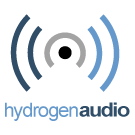From Hydrogenaudio Knowledgebase
|
|
| Line 1: |
Line 1: |
| =MP3: MPEG 1 Layer 3=
| |
|
| |
| The MP3 algorithm development started in 1987, with a joint cooperation of [http://www.iis.fraunhofer.de/ Fraunhofer IIS-A] and the University of Erlangen. It is standardized as ISO-MPEG Audio Layer-3 (IS 11172-3 and IS 13818-3).
| |
|
| |
| It soon became the de facto standard for lossy audio encoding, due to the high [[compression rates]] (1/11 of the original size, still retaining considerable quality), the high availability of decoders and the low CPU requirements for playback. (486 DX2-100 is enough for real-time decoding)
| |
|
| |
| It supports [[multichannel]] files (Although there's no implementation yet), [[sampling rate]]s from 16kHz to 24kHz (MPEG2 Layer 3) and 32kHz to 48kHz (MPEG1 Layer 3)
| |
|
| |
| Formal and informal listening tests have shown that MP3 at the 160-224 kbps range provide encoded results undistinguishable from the original materials in most of the cases.
| |
|
| |
| ==Pros== | | ==Pros== |
| * Widespread acceptance, support in nearly all hardware audio players and devices | | * Widespread acceptance, support in nearly all hardware audio players and devices |
| Line 15: |
Line 5: |
| * Anyone can create their own implementation (Specs and demo sources available) | | * Anyone can create their own implementation (Specs and demo sources available) |
| * Relaxed licensing schedule | | * Relaxed licensing schedule |
|
| |
| ==Cons==
| |
| * Lower performance / efficiency than modern codecs.
| |
| * Problem cases that trip out all transform codecs.
| |
| * Sometimes, maximum bitrate (320kbps) isn't enough.
| |
| * No multichannel implementations.
| |
| * Unusable for high definition audio (sampling rates higher than 48kHz).
| |
Revision as of 03:38, 9 October 2005
Pros
- Widespread acceptance, support in nearly all hardware audio players and devices
- An ISO standard, part of MPEG specs
- Fast decoding, lower complexity than AAC or Vorbis
- Anyone can create their own implementation (Specs and demo sources available)
- Relaxed licensing schedule
